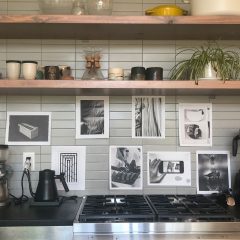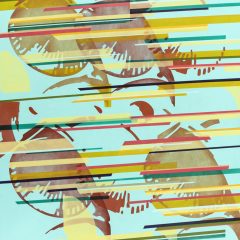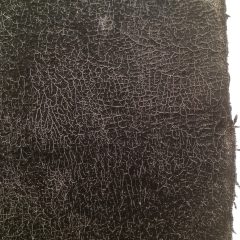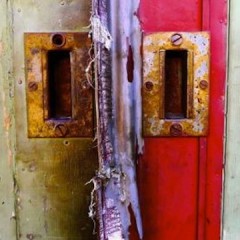Two types of minimalism sit side by side on 2nd street this month. At Larry Becker Contemporary Art Max Cole: Light and Line contains thirteen recent paintings in black and white. Cole’s work has changed in subtle shifts over 30 years and this new work is very consistent with her painting style while continuing that steady development. Horizontal stripes dominate the paintings, but on inspection some of the wide swaths are constructed of tiny parallel vertical lines that blend together into soft, tonal areas. As hairs combine to create the solid mass of a paintbrush, these individual strokes merge into foggy grey rows that evoke the even landscapes of the artist’s native Kansas home.
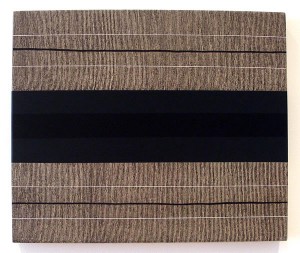
A couple of doors down at LG Tripp Gallery are more geometric line paintings. The drawings of Paul Fabozzi and paintings of Seonglan Kim Boyce have inspirations in maps and architectural drawings and strongly evoke a sense of space. The influence of the city is apparent in Fabozzi’s mathematical arrangements. The color palette and repetitive geometric figures combine to designate each component as an individual object with a trailing line that intersects the open space and crosses other paths. Despite their strict adherence to geometry and their heavy technical connotations, the random-seeming trajectories firmly connect these paintings to human activity, deepening their interest and relatability.
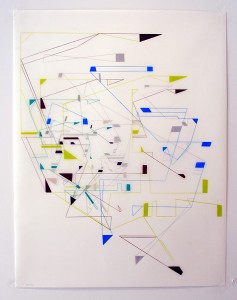
At Dalet Gallery Martha Posner and Ricardo Barros have wildly divergent shows dealing with the body under the name Fabricating Truths, Shaping Stories. Barros’ work in the show is primarily staged and manipulated photos of nude women. Photo manipulation is much maligned in a way that drawing is not despite the fact that both are constructions of the artist’s vision and Barros points out that while a photograph can no longer be trusted as factual evidence, it may still be portraying an idea or story truthfully. The themes in his works are well layered, involving voyeurism, humor, and identity.
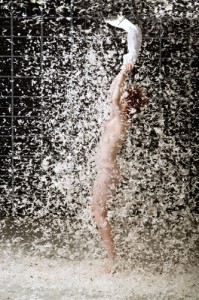
The goofball image in Leda’s Revenge is a naked woman shaking out the feathers from a pillow. Her body is so elongated and slender and her action so ineffectual that it seems ridiculous to posit this as a revenge. It invokes the playful image of pillow fights and sexuality, but the myth of Leda is one of rape. Seen as a victim of a sexual crime standing in a clinical setting trying to take her meaningless retribution she suddenly seems painfully hopeless.
In contrast to Barros’ layered clinical sensuality, Martha Posner’s constructions have a visceral grossness that actually revolted a few viewers. A youthful dress, stiffened by wax and stuffed with hair has the form of a girl, but the prevalence of residue and detritus in the materials makes it seem like a lifeless substitute created for some unknown pagan ritual. The adult-sized body in Turning is poised in mid-flight with bundles of feathers tufting out from the arm holes and skirt. It is a sickly imitation of life, with no head, no blood, no flesh. She is mother to the hairy baby portraits behind her. Together the pieces exude a painful longing and sense of loss.
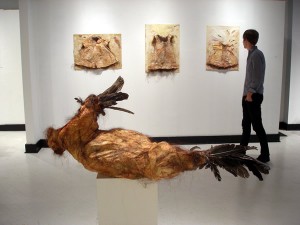
Death and loss also permeate Kezia Lechner’s prints at Silicon Gallery. Lechner has transformed images from period holocaust photos into ink drawings that have an almost child-like quality. The simplicity of her drawings strips complex images of all extraneous elements and reveals the scenes as depictions of very basic horror.
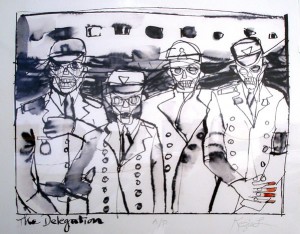
In ‘The Delegation’ Nazi officials in winter uniforms are lined up for a photo in front of a long bunker. Lechner has drawn their faces as skulls enhancing their frightening quality, but also making them more human. There is something satisfying in seeing the Nazi’s as skeletons when that imagery has always been associated with the victims of the holocaust due to starvation. The image reveals the men as monsters; soulless and dying. It was jarring on a bright spring day to happen upon these stark and painful images. We jet through our lives and try often to ignore the reality of horror, in earthquakes, bombings, wars, and other nightmares of death and evil. But the faces of these men, long dead, are recaptured to remind us.



